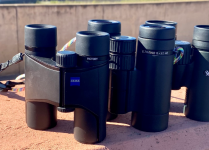There are a lot of advantages to a bigger aperture binocular. For one thing they bring in more light. For example, an 8x25 compact will bring in approximately 20% more light than an 8x20, so it will always be brighter especially in low light. An 8x25 has a bigger exit pupil of 3 mm versus 2.5 mm for the 8x20 so the cone of light reaching your eye is bigger which means eye placement will be easier because it is easier to center a larger cone of light over your eyes light receivers. A bigger aperture binocular will usually have fewer aberrations because they will pass the field stop and will never reach your eye. A bigger aperture binocular will usually have a more quality image. Here is a good article called "Size does Matter" which discusses the advantages of bigger aperture binoculars. There is a reason some people choose to carry an 8x56 even though they are very heavy and big.Dennis;
Could you explain to an amateur exactly how that works, so that a bigger aperture results in "better optics"?
"Contrary to what some of us would like to believe size really does matter. Flight, for example, imposes strict limits on size. Ostriches cannot fly because they have exceeded the size limits within which flight is possible. If, for example, I were a bird I would need a fused sternum (or “keel”) which is six feet deep to serve as the attachment point for the massive pectoral muscles I would need to operate my wings well enough to become airborne. Supporting the muscle mass and fueling the metabolism I would need for flight would require so many calories that I would have to spend virtually all of my time eating. I would, like the ostrich, give up trying and allow my flight apparatus to atrophy as the Ostrich has done. Just as size matters to birds it also matters to birders. For birders bigger, even super-sized, is better -- a lot better. (I am, of course, talking about binoculars, not Big Mac-scarfing bird watchers). A basic and immutable law of optics is that, all other things being equal, (magnification, quality, engineering, etc.) bigger objective lenses will give you a brighter, more satisfying view than smaller lenses. They will yield more detail and better color rendition than you can possibly obtain from smaller objectives. Big objective lenses allow you to see more detail in deep shadows. In a recent conversation with Clay Taylor of Swarovski Optik, Clay asked if I had tried Swarovski’s new 8x56 SLC binoculars. “Are you kidding? I’m sure they are great, but I can’t afford to hire the middle linebacker I would need to carry them for me.” But he was somewhat insistent, and I have learned to listen when Clay insists. In the years that I have known Clay he has never been wrong about optics. So I asked for a loaner pair and took them with me as my binoculars for a long weekend in Cape May which happened to coincide with Cape May Bird Observatory’s annual Spring Birding Weekend. CMBO’s Spring weekend feels like a festival. It attracts the entire population of dedicated birders from the Eastern United States -- people who spend a lot of time looking through binoculars, and who often estimate the bona fides of a stranger by what he or she is wearing around their neck -- so you can imagine that my super-sized bins provoked more than a few looks and lots of comments questioning my self-confidence. (Actually, it takes quite a bit of self confidence to carry such outlandish looking monster optics in such competitive company.) More typical comments were something like: “ Wow. I’ll bet those are really bright.” Well, yes they are very bright, but the real point -- one that most people miss -- is that they are better. I did see one other birder sporting out-sized binoculars – a pair of Leica Ultravid HD 8x50s. After a few tentative glances we struck up a conversation. I wasn’t surprised to learn that this fellow is an amateur astronomer because astronomers understand that optics are all about aperture, and they are willing to give up a little practicality to get the last iota of optical truth. So, let’s start with the weight because size and weight are limiting factors for what most of us are willing to carry. At 44 ounces these bins are heavy. They are almost a pound heavier than Swarovski’s new EL Swarovision bins. I carried them around my neck for seven or eight hours a day over the past four days, and I can’t really say that I ever got used to or forgot about the weight. These bins are not for the feint of heart. But weight does have the advantage of inertia. (Remember your high school physics?) Weight confers stability because it’s a lot harder to set a heavy object in motion than it is to move a lighter object, so the little movements of your hands have less effect on heavy binoculars than they do on their lighter cousins. That’s why rifles designed for competition are heavy. Like a really fine competition rifle these bins feel very good in the hand. They are fast focusing, and I can see the entire field while wearing my eyeglasses. The rubber armor is the same material as Swarovski used in its new EL Swarovision. I can hold them steady for a long time. But they are just beyond the limit of what I am willing to carry around for everyday birding. Yes, the 8x56 SLCs are amazingly bright, but how much brightness do you actually need? For most birding needs mid-sized binoculars (8x32) are more than adequate. In fact, when I started birding 7x35 was pretty much the standard configuration. Full-sized binoculars (7x42 or 8x42) will allow you to see incredible detail in very dimly lit environments. But keep in mind that you can only use as much brightness as your eye will admit, so any binocular whose exit pupil is larger than your eye’s pupil (if you are over 50 your eye only opens to 3 or 4mm while a 7x42 binocular has a 6 mm exit pupil) is probably providing more brightness than you can use -- even at night. So why bother schlepping these monsters around? Because it isn’t only about brightness. It’s about the quality of the image, and Swarovski’s 8x56 SLC offers perhaps the best image that I have seen in any binocular. Despite their considerable weight I found them almost impossible to put down. (And make no mistake. I really wanted to put them down.) Holly and I spent a lot of time looking at shorebirds this weekend, and I found that I was perfectly happy to let her hog the spotting scope for much longer periods than usual because I was so happy to be looking through the SLCs. These binoculars are difficult to write about because any sensible birder will need to be hypnotized into buying something this big and heavy, but keep in mind that there can be no great art without suffering. This reviewer's suffering was lost in the sheer joy of the magnificent image produced by these binoculars. The Swarovski 8x56 SLCs will not be anybody’s choice for his or her only birding binocular. But if you love shorebirds, waterfowl, hawks, or owls, you will really want to find a way to get a pair of these because they will add immeasurably to your birding enjoyment."
Wayne Mones
May 24, 2010
















